Tansy, Tanacetum vulgare – Potent Natural Pest Repellent
This post may contain affiliate links. Read my full disclosure here.
Common Tansy, Tanacetum vulgare, puts on a long lasting floral display in late summer and fall. The flat topped, yellow button like flowers are easy to spot, and the fernlike foliage has a distinctive aroma when crushed. We’ll share some identification and control tips, history, and uses.
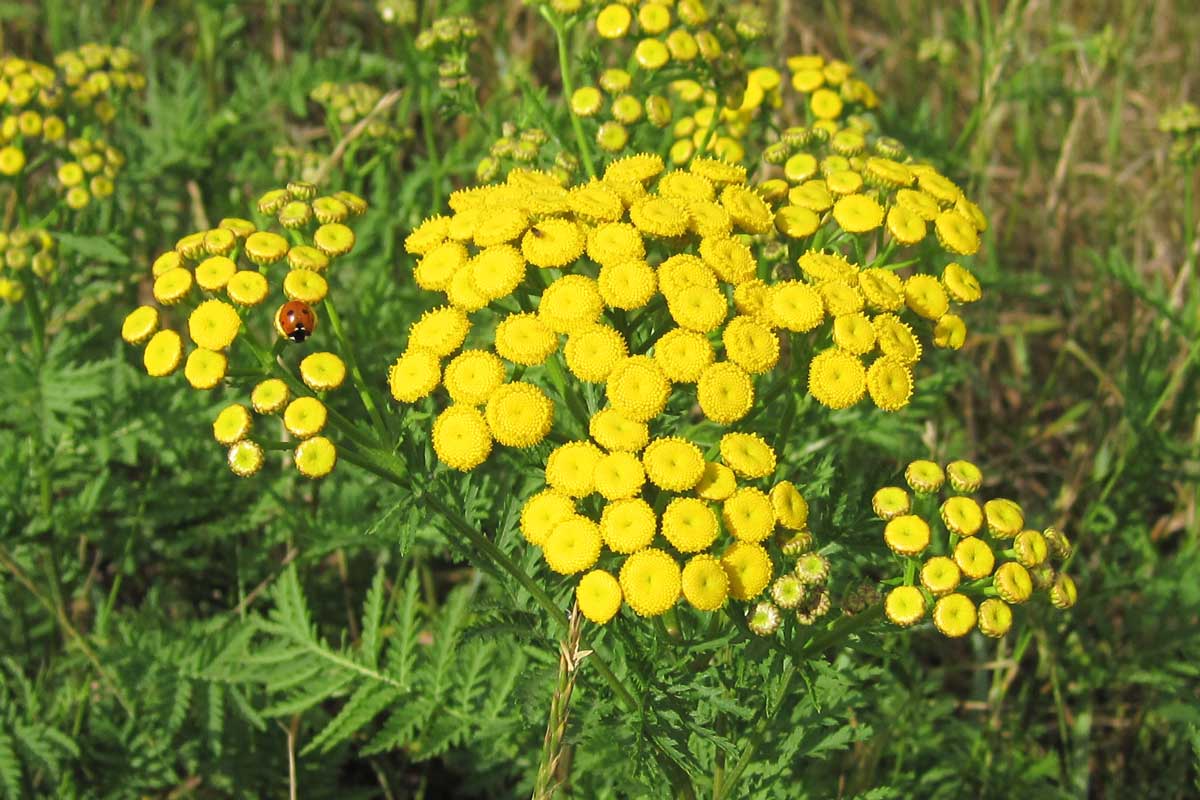
Tansy Characteristics and Identification
Tanacetum vulgare is a perennial, typically growing 2-4 feet tall (60-100 cm). It spreads via seed and rhizome. Even a small piece of root fragment can spawn a new plant.
The roots form a dense mat of shallow runners. Once established, it’s hard to eliminate, so be careful about encouraging it where it might become a nuisance.
Flowers
The small, yellow and button-like flowers appear in summer and fall. The little “buttons” are about 1/2″ across. They look like the center of a daisy without any white petals.
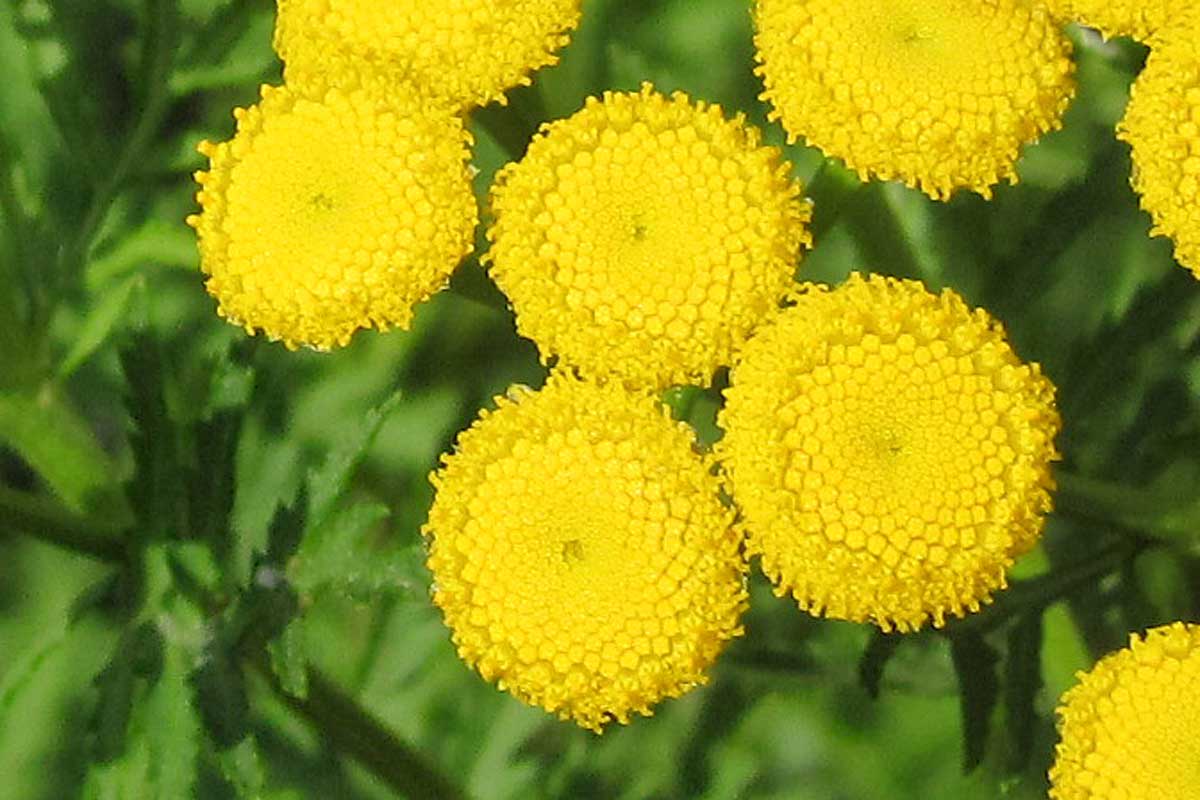
The flowers are composite, i.e. made up of many tiny flower heads. Clusters of many buttons crown the tops of the plants.
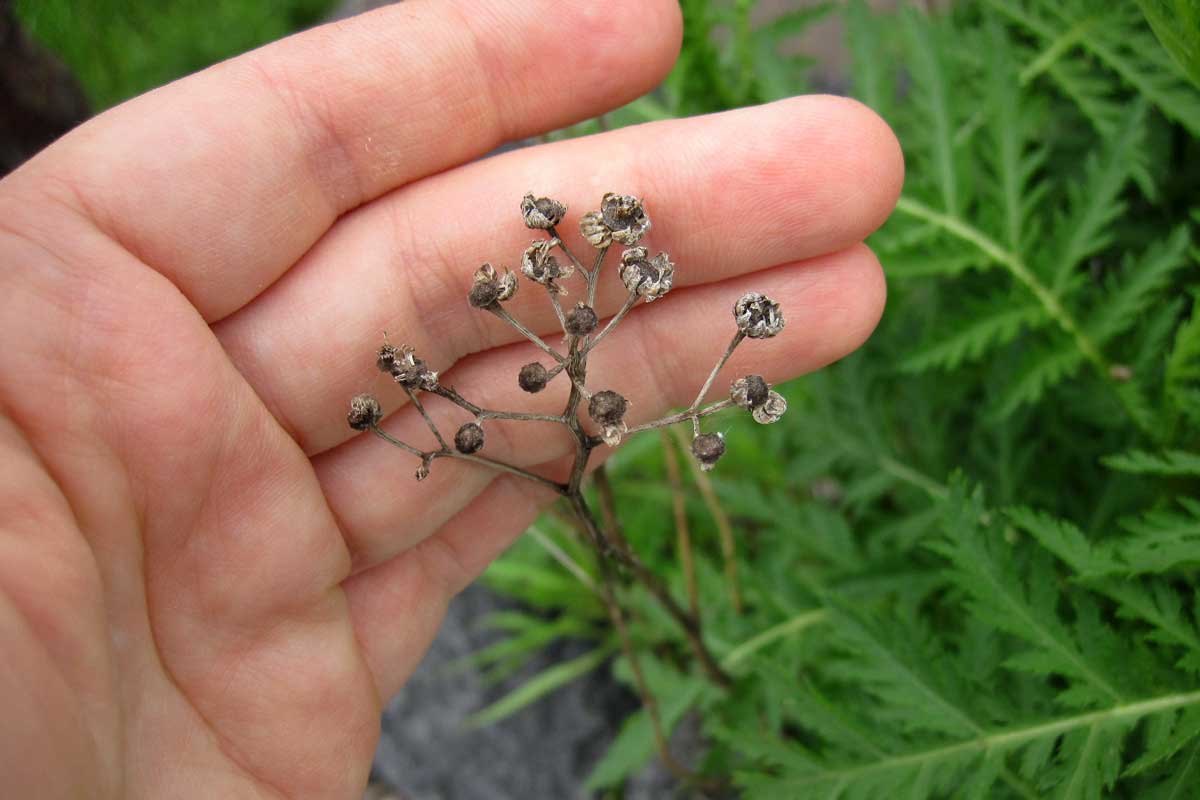
Leaves
The fern-like leaves attach in an alternating pattern up the length of the stem. They range from 4 – 8″ (10 – 20 cm) long with many sharp teeth. Leaves get smaller towards the top of the stem.
The plant stem is smooth, not prickly. The plant is strongly aromatic when crushed, which has led to its use as a bitter tonic and pest repellent.
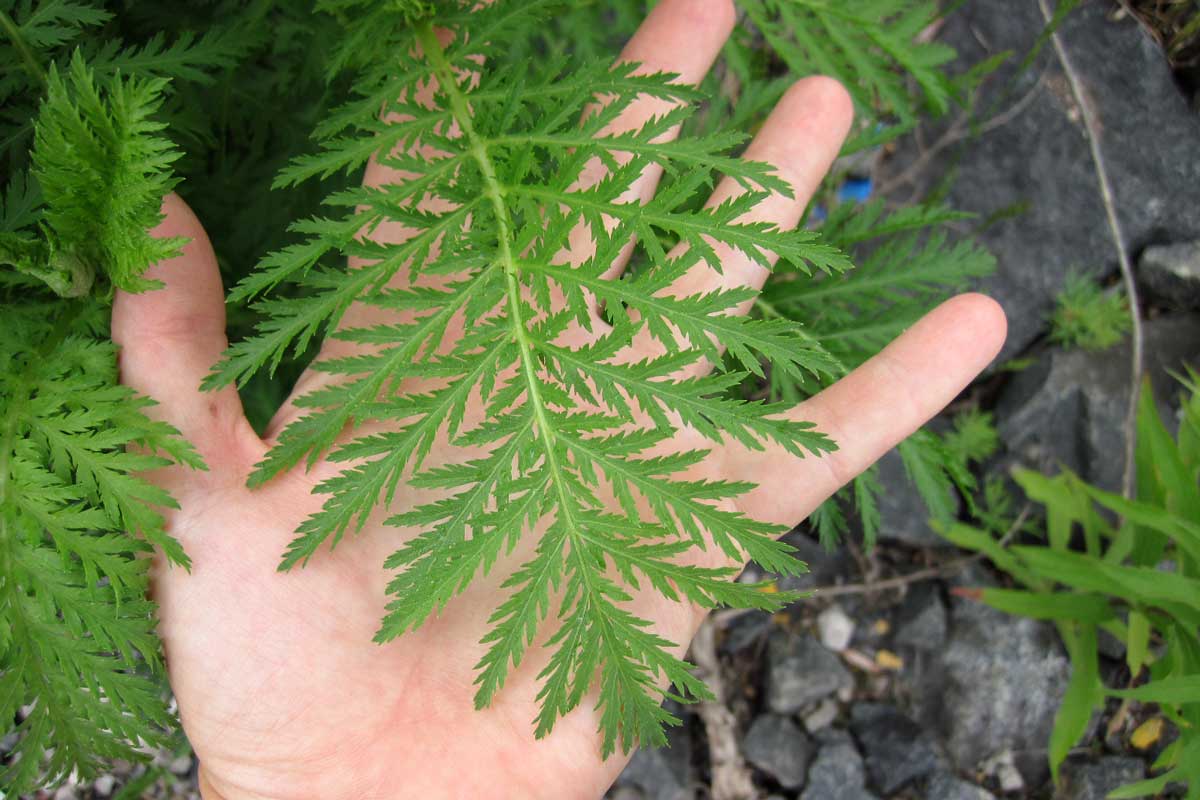
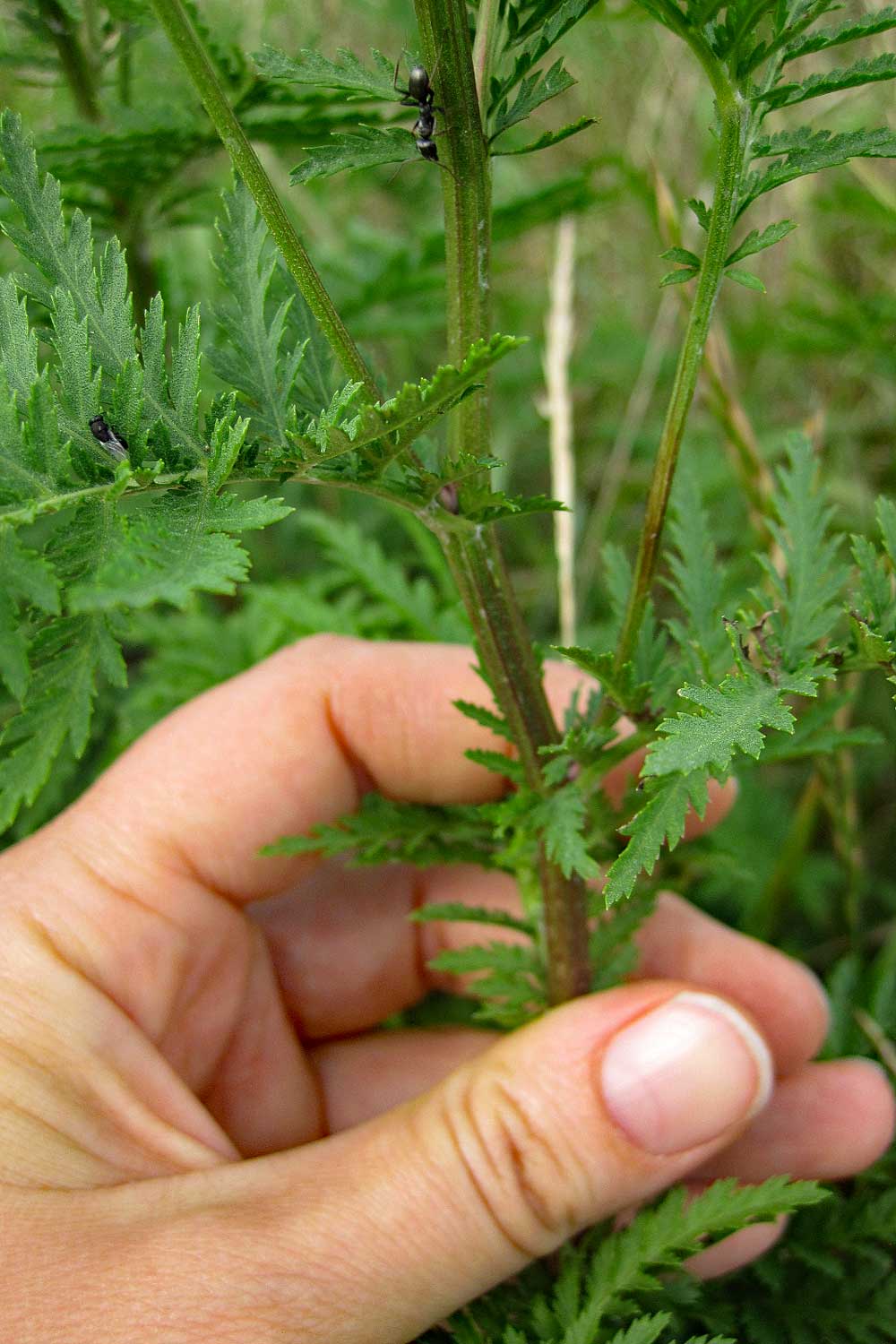
Where Does Tansy Grow?
Tansy prefers dry ground in full sun and disturbed soils. It often forms dense clumps of growth which display bright yellow blasts of color along the roadside.
Tansy is native to Eurasia, but is now found around the world. In North America, it ranges from the arctic circle to the southern United States (see map). Several state list is as a noxious weed.
Control
The plant may cause contact dermatitis in sensitive individuals, so wear gloves when handling to prevent exposure. You may hand pull small infestations, which works best when the plants are young. Mowing helps reduce spreading, but don’t mow when the seeds are fluffy. That can make it spread faster.
The book “When Weeds Talk” notes that Tanacetum vulgare thrives where soil calcium and phosphorous levels are very low. Potassium, magnesium, manganese, and copper levels are generally high. Humus, porosity, and beneficial bacteria levels are low.
Focus on soil health, and weed problems improve naturally. Try adding gypsum for calcium, compost or humic acid, or bone meal for calcium and phosphorous.
Other Common Names for Tansy
Other names for Tanacetum vulgare include:
Would you like to save this?
- Wild Tansy
- Gold Leaf Tansy
- Stinking Willie
- Bitter Buttons
- Ginger Plant
- Cow Bitter
- Scented Fern (for the odor)
- Cheese (for the flowers)
- Golden Buttons
Plants it May be Confused With
This is not the same plant as Artemisia vulgaris, Common Mugwort, which has inconspicuous flowers. Tansy Ragwort, Senecio jacobaea, is another daisy family plant. It has yellow flowers with yellow petals.
Found in the Mediterranean basin, Tanacetum annuum, blue tansy is named for its blue essential oil. It also has yellow button flowers, but the foliage is more like evergreen needles.

Tansy Uses
Tansy has a history of use for both food and medicine. However, it contains the toxic substance thujone, which is dangerous in large doses. Do not use while nursing, pregnant, or on medications. High doses may cause miscarriage, liver and brain damage, and even death.
The Holistic Herbal suggests the use of tansy tea for intestinal worms and rheumatism. It also suggests its use as a digestive aid to ease stomach upset and flatulence (as a bitter herb). Recent studies show tansy essential oil to have strong anti-fungal and antibacterial properties.
A Modern Herbal describes other historical uses. Medicinally, it was used for gout treatment and deworming, and externally for skin eruptions. There’s a recipe for tansy cakes, and notes for use as a spice and flavoring.
Insect Repellant and Preservative
Tansy’s botanical name, Tanacetum, is thought to be derived from the Greek word athanasia, meaning “immortality”. Historically, tansy was used for embalming. It was packed in coffins, tucked in funeral wraps, and made into wreaths to adorn the dead.
The flowers last for a long time after cutting, and have preservative properties. The Volga Germans used it to protect meat from flies, and it was used a strewing herb on floors to keep pests at bay. A study of medicinal plants of Russia notes its effectiveness against flies, lice and fleas. Powder aerial parts of tansy caused 100% paralysis in flies within 15 minutes.
In the garden, it serves as a companion plant, warding off common pests such as Colorado potato beetles. It accumulates potassium, making it a useful addition the compost pile.
Wildlife Habitat
When I was taking photos of the tansy plants, they were gently humming with a variety of insects. They are popular with nectar and pollen feeders, but their bitter taste keeps them largely safe from foliage eaters. They will give an “off” taste to milk if consumed by cattle or goats. In its native Europe it has more insect pests that feed on the foliage.
The Weekly Weeder Series
This article is part of the Weekly Weeder series, which shares how to use wild plants for food, medicine, and more.
Other popular articles in the series include:
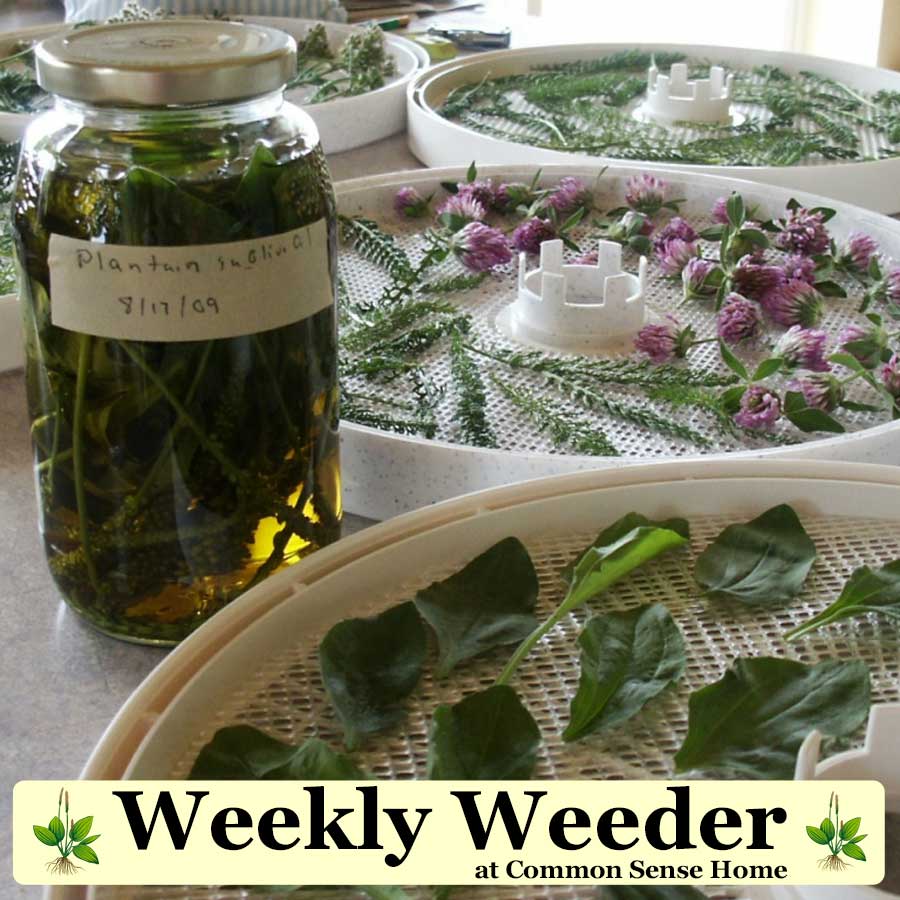

This article is written by Laurie Neverman. Laurie was raised on a small dairy farm in northwest Wisconsin, where she gathered wildflowers from the woods and pastures. She and her family now live in northeast Wisconsin, where they combine intentional plantings and semi-wild areas. Every season is a new opportunity to learn more about working with wild plants.
Originally posted in 2013, last updated in 2024.

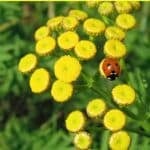




Tansy is also a good way to kill a horse. I will continue to kill it when I find it.
If you have it in a horse pasture, that seems like a logical choice.
It makes a lovely yellow dye too. It’s considered an invasive weed here and our roadsides are full of it so no one seems to mind that I gather it by the armload this time of year.
Thanks for this interesting post about the Tansy. We have it growing wild all over around here. I think I may try to find some way to use it. Maybe for insect repellant…